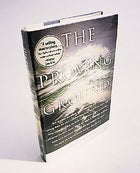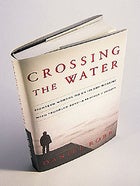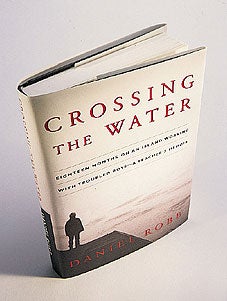The Proving Ground: The Inside Story of the 1998 Sydney to Hobart Race,
by G. Bruce Knecht (Little, Brown, $25).
From Our Pages
My Story as Told by Water: Confessions, Druidic Rants, Reflections, Bird-Watchings, Fish-Stalkings, Visions, Songs and Prayers, Refracting Light, From Living Rivers, In the Age of the Industrial Dark,by David James Duncan (Sierra Club Books, ). This free-form collection from the Northwest’s bard of trout includes two essays that first appeared in ���ϳԹ���.


Not an hour into the 1998 Hobart–the 630-mile race from Sydney to the Tasmanian port of Hobart–a computer at the Australian Bureau of Meteorology spit out the bad news. “It’s going to be a massacre,” one forecaster declared after seeing that cyclone-strength gales were converging on the course. Meanwhile more than a hundred boats were headed toward the treacherous Bass Strait, the boiling strip of water separating Tasmania from Australia. Most skippers, used to the Hobart’s tough conditions, ignored the radioed warning and sailed into the teeth of it. The storm shredded spinnakers, crushed boats, and led to the largest maritime rescue effort in Australian history. Wall Street Journal correspondent Knecht ably chronicles the fortunes of three yachts, including one skippered by American software magnate Larry Ellison. Knecht recounts the race at a breathless edge-of-the-seat pace, pausing to note the acts of cowardice and courage that such conditions inspire: a captain refusing to assist a rival boat in distress, a sailor in a life raft suppressing his terror to avoid collapsing his mates’ “linked line of emotional defense.” Only 43 boats arrived in Hobart. Seven were abandoned; five sank. The rest turned back. Fifty-five sailors were rescued. Six died. Ellison, Oracle’s swaggering CEO, emerged humbled. “We felt like sending out a radio call and saying, ‘Everyone go home. This is just insane,'” he recalled. “This is not what sailboat racing is supposed to be about.” –Bruce Barcott
Crossing the Water: Eighteen Months on an Island Working with Troubled Boys–A Teacher’s Memoir,
by Daniel Robb (Simon & Schuster, $24).
Furnished with a rustic dormitory, an outhouse, an ocean view, four long-suffering teachers, and eight or nine delinquents, Penikese Island–75 acres of salt hay and sumac off Cape Cod–is home to a reform school where Nature plays counselor. Daniel Robb spent a year and a half there mentoring teenage boys whose crimes ranged from flunking out of foster homes to attempted murder. Robb tries to instill algebra, poetry, and life lessons in his charges as the island does the rest. The boys’ humble, engaging chores–caring for farm animals, rebuilding fences, and lobstering–help fill the vacuum left by abuse, leading kids whose idea of an endearment is “cocksucker” to care about something besides urban survival. Ned, a metalhead fond of satanism, valiantly tries to revive a limp mouse with CPR, and James, sent to the island for “beating his mother’s boyfriend senseless with a chair,” is fascinated to discover that whales are mammals, not fish. (“What, lady whales got tits and all?”) Without lapsing into sentimentality–one school founder jokes that “we turn a lot of potential murderers into car thieves”–this graceful memoir reveals the mettle of kids who can persevere past the chaos of their lives to an epiphany like this: “I useta be a bad-ass fuckup, and now I don’t really want to be one as much.” –Caroline Fraser
All Elevations Unknown: An ���ϳԹ��� in the Heart of Borneo,
by Sam Lightner Jr. (Broadway Books, $25).
In 1999, the author, a climber, set out on his fourth trip to Malaysia, despite misadventures there that included hosting egg-laying flies in his sinuses (as he found when a maggot fell out of his nose). Bent on climbing Batu Lawi, a nearly apocryphal jungle spire, Lightner adopts as his guide a World War II memoir by a British commando who used the mountain as a marker when he parachuted into Japanese-controlled Borneo in 1944. Lightner and his German buddy Volker, along with several other climbers, a camera crew, and local Kelabit porters, arrive at Batu Lawi only to be frustrated by thunderstorms and a fever that lays Volker low. They summit, but not before a bitter dispute between climbers and cameramen over how to climb safely while supplying sponsors with “decent film.” Never fully resolved, the disagreement adds drama to an otherwise breezily told tale, one that will bring you as close to Borneo’s bamboo vipers, foot rot, and sweat bees as you may want to get. –C.F.
Kiss or Kill: Confessions of a Serial Climber,
by Mark Twight (The Mountaineers Books, $23).
“I was supposed to mellow out as adulthood gained a foothold,” boasts 39-year-old Mark Twight, “but I am angrier than I was ten years ago.” Is anyone angrier than Twight? Certainly not in the climbing world, where the American alpinist is known as much for his Dr. Doom persona as for the vertical limits he pushes at a fast and furious pace. This collection of 16 years of his writing brings together expedition narratives, rants, and bits of fiction that should do nothing to brighten his dark reputation. “I’m an elitist prick and I think posers have polluted mountaineering,” Twight declares. With a punk DIY ethic and Nietzschean reverence for strength and pain, he climbs a lot of mountains and crushes a lot of friendships. “My life is full of shit and blood and pain,” he writes, “but I’ll take it all without analgesic or complaint if I get to win big every now and then, especially if I win in the company of a man who I care about.” The character who emerges is a walking cautionary tale, one who has given in to his climbing obsession–to be the hardest man on the hill–and is willing to pay dearly. –B.B.

